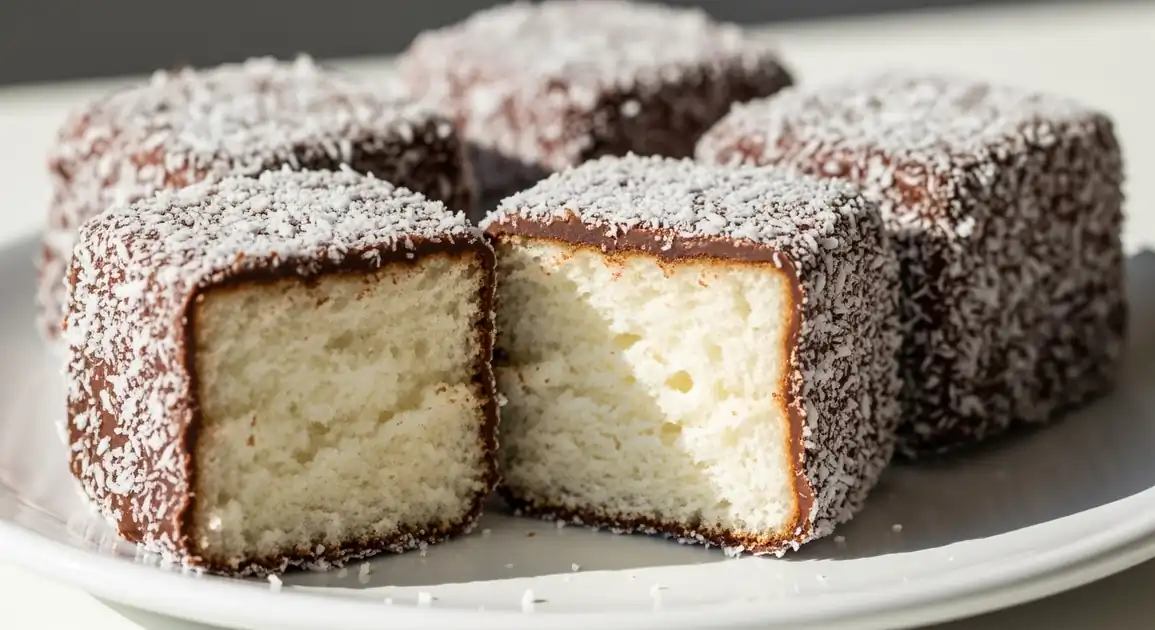Lamingtons
Lamingtons

Description
Sydney, as Australia's largest city, boasts a huge array of places to find lamingtons, from classic neighborhood bakeries serving traditional versions to trendy cafes offering modern twists and high-end patisseries crafting gourmet interpretations. You can find them easily across the city.
Dietary Information
Serving information
Serving style
Served individually on plates in cafes, often sold singly or in packs from bakeries. Sydney's diverse food scene means you can find both very traditional and highly stylized lamingtons.
Quick facts
Bakeries: Typically 6 AM - 5 PM. Cafes: Typically 7 AM - 4 PM. Some variations apply.
Safety Tips
What to Look For
-
Fresh appearance (soft sponge, moist coconut)
Indicates the lamington hasn't been sitting out for too long. Dryness is the main quality and potential minor safety (staleness) concern for plain versions.
-
Reputable source (busy bakery, trusted cafe, known brand)
Established vendors are more likely to follow proper hygiene and storage practices.
-
Proper storage for filled versions
Cream-filled lamingtons MUST be kept refrigerated to prevent bacterial growth. Check if they are stored in a chilled display.
-
Clean display cases and handling
Ensure the cakes are protected from contamination and handled with tongs or gloves.
What to avoid
-
Dry, crumbly looking sponge
Indicates staleness, affects quality and potentially suggests poor storage.
-
Discolored or very dry coconut coating
Suggests the lamington is not fresh.
-
Cream-filled lamingtons left at room temperature
Poses a significant food safety risk due to potential bacterial growth in the cream.
-
Cracked or weeping icing
Can indicate temperature fluctuations or staleness.
Price information
Price range
Budget tips
- Explore bakeries in outer suburbs for potentially lower prices than inner-city cafes.
- Supermarket options remain the most budget-friendly for bulk buys.
- Look for morning/afternoon tea deals in some cafes.
Value indicators
- Recommendations from locals or positive online reviews for specific bakeries/cafes.
- Appearance of freshness (soft sponge, moist coconut).
- Use of quality ingredients (e.g., good chocolate, real butter in sponge) in higher-end versions.
- Balance of cake, icing, and coconut.
Where to Find This Dish
Surry Hills / Darlinghurst
Trendy areas with numerous cafes and bakeries offering both classic and modern takes on cakes.
Crown Street, Oxford Street
Daytime cafe/bakery hours
Inner West (e.g., Newtown, Marrickville)
Known for strong local bakery culture and diverse cafes.
King Street (Newtown), Marrickville Road
Daytime cafe/bakery hours
Local Shopping Strips
Neighborhood bakeries in various suburbs (e.g., Bondi, Chatswood, Parramatta) are reliable sources.
Suburban main streets, Local shopping centres
Morning, Daytime
Vendor Tips
- Check out artisan bakeries for potentially higher quality, possibly gourmet versions.
- Ask cafes if their lamingtons are baked in-house or sourced locally.
- Look for specialist cake shops or patisseries for refined versions.
How to Order
Regional Variations
-
Gourmet/Artisan Lamingtons
(Gourmet/Artisan Lamingtons)
Sydney's vibrant food scene encourages chefs and bakers to create upscale lamingtons using premium chocolate, alternative sponge flavors, unique fillings (e.g., salted caramel, native Australian fruits), or different textures.
-
Gluten-Free/Vegan Options
(Gluten-Free/Vegan Options)
More readily available in Sydney's health-conscious cafes and specialist bakeries compared to smaller towns.
-
International Fusion Lamingtons
(International Fusion Lamingtons)
Occasionally, cafes might offer fusion versions incorporating international flavors (e.g., matcha icing, pandan sponge).
Cultural context
History
Widely accepted as an Australian invention, the lamington is most often linked to Lord Lamington, Governor of Queensland (1896–1901). Anecdotal stories attribute its creation to his chef, Armand Galland, who perhaps needed to stretch a leftover sponge cake for unexpected guests, dipping slices in chocolate and coconut. Another story suggests it was an accident involving dropping cake into chocolate. Regardless of the exact origin, the cake quickly gained popularity and became synonymous with Australian baking, particularly for afternoon tea and fundraisers.
Local significance
A familiar and well-loved cake representing Australian baking tradition within Sydney's diverse culinary landscape.
Eating customs
- Enjoyed with coffee ('flat white', 'cappuccino') or tea.
- Suitable for casual snacks or informal desserts.